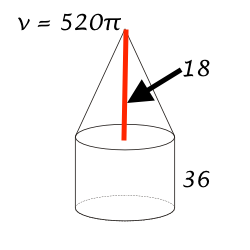A solid consists of a cone on top of a cylinder with a radius equal to that of the cone. The height of the cone is #18 # and the height of the cylinder is #36 #. If the volume of the solid is #520 pi#, what is the area of the base of the cylinder?
1 Answer
Here is a diagram.
Explanation:

First, let's identify the formulae for volume of a cone and volume of a cylinder.
The total volume of the solid is given by adding the volumes of these two solids together. Therefore, we can state that:
Let's now identify the elements that we know:
•Total volume
•Height of the cylinder
•Height of the Cone
All that is left for us to find is the radius.
Hence,
We can now find the area of the base of the cylinder, which because it's a circle, is given by
The area of the base of the cylinder is
Hopefully this helps!

